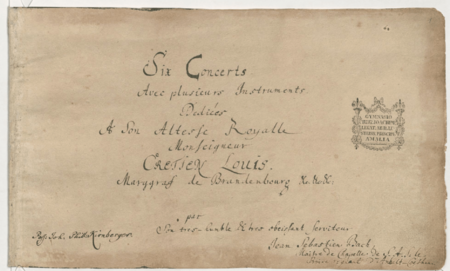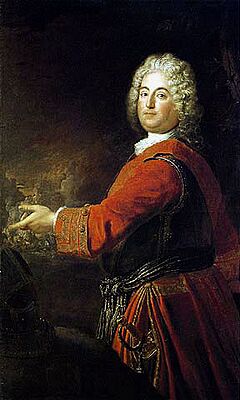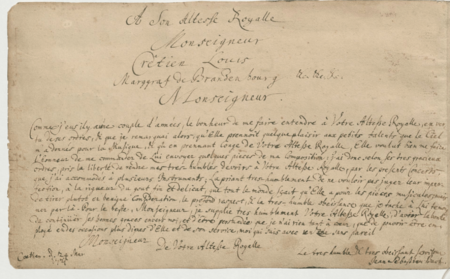Brandenburg Concertos facts for kids
Quick facts for kids Brandenburg Concertos |
|
|---|---|
| Concertos by J. S. Bach | |

Title page, in French, of the six concertos
|
|
| Catalogue | BWV 1046–1051 |
| Form | Six concertos, each of several movements |
| Composed | Collection assembled in 1721 |
The Brandenburg Concertos (BWV 1046–1051) are a famous collection of six musical pieces by Johann Sebastian Bach. He gave them to Christian Ludwig, a German prince, in 1721. The original French title means "Six Concertos for several instruments." These pieces are known for using many different instruments together and are considered some of the best orchestral music from the Baroque era (a period of music from about 1600 to 1750).
History of the Brandenburg Concertos
It's not fully known when Bach wrote all the music for the Brandenburg Concertos. Some parts were likely composed earlier. For example, the first movement of Concerto No. 1 might have come from a piece Bach wrote in 1713. Concerto No. 5 was probably one of the last to be finished. It features a special part for the harpsichord, which was a new instrument Bach bought in 1719.
In 1721, Bach put together these six concertos. He wrote them out almost entirely by hand. He then gave the collection to Christian Ludwig, a prince, with a special message dated March 24. In this message, Bach humbly offered his music, hoping the prince would enjoy his "little talents." This meeting likely happened when Bach visited Berlin in 1719 to buy the new harpsichord.
Bach called his pieces "Concertos for several instruments." This was a modest way to describe them. Music experts say Bach used a huge variety of instruments in daring and new ways. Each of the six concertos was unique in how it used instruments.
What Happened to the Concertos Later?
Many people thought that Prince Christian Ludwig didn't have enough musicians to play these concertos. They believed the music just sat in his library until he died in 1734. However, some experts disagree, saying it's unlikely Bach would send music that couldn't be played.
After the prince's death, it's unclear who owned the concertos next. We know that Bach's student, Johann Kirnberger, later had them. He then passed them to Princess Anna Amalia. Eventually, the music ended up in the Royal Library of Berlin in 1914.
During World War II, the handwritten music almost got lost. A librarian was transporting it by train for safety when the train was bombed. The librarian escaped to a forest, hiding the precious scores under his coat. Luckily, the original manuscript is still safe in the Berlin State Library today.
For a long time after Bach's death, only the fifth concerto was well-known. The others were mostly forgotten. Then, in 1849, a man named Siegfried Dehn found them in Princess Amalia's library. He had them published for the first time the next year.
The concertos became truly popular with the invention of recording technology. The first full recording was made in 1936. Also, a growing interest in playing music exactly as it was performed in Bach's time helped make these pieces famous again.
A recording of Concerto No. 2 was even sent into space in 1977 on the Voyager Golden Record. This record contains sounds and music from Earth for any aliens who might find it!
The Six Concertos
Here's a quick look at each of the six Brandenburg Concertos:
| Concerto | Key | BWV | Solo Instruments |
|---|---|---|---|
| Brandenburg Concerto No. 1 | F major | 1046 |
|
| Brandenburg Concerto No. 2 | F major | 1047 |
|
| Brandenburg Concerto No. 3 | G major | 1048 |
|
| Brandenburg Concerto No. 4 | G major | 1049 |
|
| Brandenburg Concerto No. 5 | D major | 1050 |
|
| Brandenburg Concerto No. 6 | B-flat major | 1051 |
|
Concerto No. 1 in F major, BWV 1046
This concerto is the only one in the collection with four movements (sections).
- [no tempo indication] (usually played fast or moderately fast)
- Adagio (slow) in D minor
- Allegro (fast)
- Menuet – Trio I – Menuet da capo – Polacca – Menuet da capo – Trio II – Menuet da capo
Instruments: two natural horns, three oboes, bassoon, violino piccolo (a small violin), two violins, viola, and basso continuo (instruments like harpsichord, cello, or violone that play the bass line and chords). Length: about 22 minutes.
Concerto No. 2 in F major, BWV 1047
- [no tempo indication] (usually played fast)
- Andante (moderately slow) in D minor
- Allegro assai (very fast)
Solo Instruments: natural trumpet, recorder, oboe, violin. Other Instruments: two violins, viola, violone, cello, and harpsichord. Length: about 13 minutes.
The trumpet part in this concerto is very difficult to play. It was written for a special kind of trumpet player from Bach's time. Because of how these old trumpets were made, they usually didn't play in the slow, minor-key second movement.
As mentioned before, the first movement of this concerto was chosen to be on the Voyager Golden Record. This record was sent into outer space on the Voyager probes.
Concerto No. 3 in G major, BWV 1048
This is the shortest of the six concertos.
- [no tempo indication] (usually played fast or moderately fast)
- Adagio (slow) in E minor
- Allegro (fast)
Instruments: three violins, three violas, three cellos, and harpsichord. Length: about 10 minutes.
The second movement is very short, just two chords. It's thought that these chords were meant to frame a solo part that the harpsichord or violin player would make up on the spot. Today, performers sometimes play just the chords, or they might add a short solo piece.
Concerto No. 4 in G major, BWV 1049
- Allegro (fast)
- Andante (moderately slow) in E minor
- Presto (very fast)
Solo Instruments: violin and two recorders (called "flauti d'echo" in the original score). Other Instruments: two violins, violas, violone, cellos, and basso continuo. Length: about 15 minutes and 20 seconds.
The violin part in this concerto is very challenging, especially in the first and third movements. The "flauti d'echo" parts are usually played on alto recorders today. Sometimes, the recorders are placed offstage to create an "echo" sound.
Concerto No. 5 in D major, BWV 1050
- Allegro (fast)
- Affettuoso (with feeling) in B minor
- Allegro (fast)
Solo Instruments: harpsichord, violin, flute. Other Instruments: violin, viola, cello, and violone. Length: about 23 minutes.
The harpsichord is very important in this concerto. It plays both as a solo instrument and as part of the background. It's believed Bach wrote this concerto around 1719 to show off a new harpsichord he bought. It's also thought he wrote it for a music competition.
This concerto is famous for its long solo part for the harpsichord in the first movement. Bach himself was a great harpsichord player, and he likely played this solo at the first performance. Many experts see this piece as one of the first examples of a concerto where a keyboard instrument plays a main solo role.
Concerto No. 6 in B-flat major, BWV 1051
This concerto is unusual because it doesn't use any violins.
Instruments: two normal violas, two violas da gamba, cello, violone, and harpsichord. Length: about 16 minutes.
The viola da gamba was an older instrument even in Bach's time. Bach's employer, Prince Leopold, was interested in this instrument, which might be why Bach included it.
In the first movement, the two violas start with a lively tune that sounds like a canon (where instruments play the same melody but start at different times). The other instruments gradually join in. The last movement is lively and dance-like, similar to a gigue.



